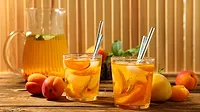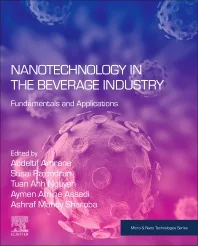Herbs and botanicals offer fortification, flavor
“What I’m seeing in the industry right now is a move toward functional beverages,” says Patrick Anderson, western regional sales manager for Terry Laboratories, Melbourne, Fla. “The herbs and botanicals that are being used in beverages now are being asked to perform as an enhancement to the actual beverage itself.”
The development of functional beverages also has provided consumers with alternatives to receiving supplements in pill format.
“Beverages provide an excellent delivery system for healthy supplementation,” says Joe Raimondo, president of Artiste, Waldwick, N.J. “Although everyone begins with the best intentions, it is difficult not to get tired of swallowing pills every day. Putting herbs and botanicals into beverages provides an easy, tasty delivery system that requires much less of an effort for many people to maintain.”
To assist in the development of these functional beverages, companies are turning toward herbs and botanicals to add function and flavor, including options in the on-premise segment. According to Chicago-based Technomic Inc.’s MenuMonitor database, in the fourth quarter of 2011 the top herbs and spices used in non-alcohol beverage menu descriptions were ginger, mint, cinnamon, peppermint, lavender, sage, lemongrass, cardamom, salt and basil. Many of the beverages containing these ingredients were tea, but some also were carbonated soft drinks and juices, the firm notes.
For adult beverages, the top herbs and spices were mint, ginger, cinnamon, salt, basil, sage, black pepper, anise, nutmeg and peppermint. However, Technomic reports that some of these terms were used to describe wine.
“Herbs, spices and botanicals are becoming popular ingredients in menu cocktails as an effort to target the health-conscious consumer,” says Stephanie Weil, product manager and beverage scientist with Wild Flavors Inc., Erlanger, Ky.
The right dosage
Herbs and botanicals are assisting beverage developers in fueling consumers’ desire for products that provide them with energy, aid digestion, relieve joint pain as well as help them relax.
Wild Flavors’ Weil cites research that more than half of U.S. non-alcohol beverage consumers are concerned about the health effects of drinking soda, which has resulted in many consumers saying they plan to drink more healthful, natural and lower-calorie options with a majority stating they want to try new flavors and less sweet products.
“Herb and botanical extracts offer unique flavors as well as have a healthy and functional perception,” Weil says.
Although herbs and botanicals are appealing to consumers, some suppliers think the ingredients have not yet reached their peak.
“Though there are exceptions, botanicals for the most part are being used as secondary or tertiary ingredients for marketing only and are rarely the key drivers of taste or function,” says Petra Tanos, North American business development manager with Martin Bauer Inc., Secaucus, N.J. “Currently, botanicals are not being used to their full potential.”
Mark Blumenthal, founder and executive director of Austin, Texas-based American Botanical Council and editor of HerbalGram, questions the efficacy of herbs and botanicals as they currently are being administered.
“The fact of the matter remains, if you put an extract of ginseng in your product, how much ginseng is in the final product?” he asks.
Blumenthal acknowledges that herbs such as ginseng can carry a taste profile that consumers might not find pleasing, so beverage-makers might use lower levels or a lesser concentration, which could diminish the desired marketing effect.
“Different manufacturers may theoretically be using different levels of these herbal extracts, different concentrations [and] different quantities of the extract,” he says.
When adding botanicals at doses that deliver true functional benefits, it could result in strong, bitter, earthy or sour notes that need to be masked, Martin Bauer’s Tanos says. She suggests combining these ingredients with tea, juices or other botanicals that can manage those off-notes.
“While incorporating a functional botanical into a formulation and putting it on the label is not difficult, it does become a challenge when you look to go beyond marketing and deliver functionality using standardized, high-potency materials in the correct dosage,” Tanos adds.
In addition to taste, another challenge that comes with using herbs and botanicals is solubility and price point.
“To include an efficacious dose of these ingredients, you challenge both the flavor profile and the price point of these products,” Artiste’s Raimondo says. “Additionally, some companies are hesitant to label their products as ‘dietary supplements’ rather than as a food product, although that concern seems to become less of an issue year after year.”
But when beverage-makers are evaluating price points, another concern suppliers have is that companies avoid using adulterated ingredients.
“When you buy an extract, the possibility that the botanical could be adulterated is extremely high,” says George Pontiakos, president and chief executive officer of BI Nutraceuticals, Long Beach, Calif. “If you’re buying a botanical from a properly managed company that has the infrastructure in place to identify, source, survey, task and process botanicals, then you’re getting a really good product that is correct to the species, correct to the maker and is processed correctly and organically.”
Extracts in beverages can be among the easiest products to adulterate, Pontiakos says, so beverage developers need to be mindful of that. If a product is priced 10 to 15 percent below market value, it is likely that the extracts have been adulterated, he adds.
Energized inclusions
Although suppliers see more opportunities for the use of herbs and botanicals in beverages, some options have already found their spots in the beverage market. A lot of activity can be seen with herbs used in the energy drink market such as ginseng, ginkgo biloba and guarana, suppliers note.
“Guarana and ginseng are popular ingredients used in energy drinks, especially as the demand for ‘natural energy’ increases,” Wild Flavor’s Weil says.
American Botanical Council’s Blumenthal says that the guarana bean, found in South America, contains 4 to 5 percent caffeine, which makes it one of the richest natural sources of caffeine. Because of the natural presence of caffeine in guarana extract, it makes the ingredient a popular caffeine booster in coffee, tea and energy drinks.
Another popular ingredient known for its caffeine-boosting properties is green tea. In addition to green tea beverages, beverage-makers also are using green tea extract for its natural caffeine components.
“People are drinking more green tea and there’s more green tea showing up in all kinds of beverages because the buzz on green tea is out there regarding all of its cardiovascular and cancer preventative effects,” Blumenthal says.
What helps green tea differentiate itself from other forms of tea is that green tea is dried quickly and not allowed to ferment, he adds. This helps the variety to maintain the polyphenols and catechins for which green tea is known, he says.
“High antioxidant activity and other health benefits break down to some extent in oolong tea, and they’re almost completely broken down in black tea,” Blumenthal says. “You have different chemistry in green tea, oolong tea and black tea depending on your level of progression of the fermentation process in tea.”
As more consumers express a desire for natural and healthy beverages, Wild Flavor’s Weil foresees that the overall tea category will continue to boom.
Healthy focus
Although herbs and botanicals can be commonly found in many energy formats for beverages, they also offer many more functional properties. L-theanine, a natural component in green tea, has been shown to have an anti-anxiety effect that allows people to stay focused, Blumenthal says.
In addition to L-theanine, BI Nutraceuticals’ Pontiakos says valerian root is popular for calming beverages, while Martin Bauer’s Tanos says chamomile can deliver actives for relaxation.
“Relaxation and stress relief products are a trend right now,” Wild Flavor’s Weil says. “Many herbs and botanicals have relaxation effects making them standard ingredients in these products.”
Herbs and botanicals also are being used to cater to the preventative health concept that consumers and beverage developers are embracing.
“The continuously growing awareness of preventative health as a category contributes to the continued growth of these products — the idea of taking small steps now to prevent health issues rather than waiting until they become a condition that requires pharmacological medication to treat,” Raimondo says.
Digestive health beverages are among the preventative health category offerings. Pontiakos says digestive health is one of the larger categories that uses selenium and additional ingredients.
Terry Laboratories’ Anderson says aloe vera also remains a popular solution to digestive health issues.
“Adding [aloe vera] as an additive to a drink and putting aloe vera on the label lets people know, one, that it’s safe, and two, it’s definitely going to function in some type of digestive capacity,” he says.
Anderson adds that an increase in studies and information will benefit the future use of herbs and botanicals, but in order to get the word out about the numerous ingredients, he predicts that marketing will play a vital role in the future.
“When I think of what is on the horizon for herbs and botanicals, it would be marketing because there are so many people that don’t know that these beverages exist because a lot of people don’t shop online … so they don’t know what is actually hitting the market,” he says. “So the horizon would be getting the information out there to actually get more people to try these beverages.” BI
Looking for a reprint of this article?
From high-res PDFs to custom plaques, order your copy today!






